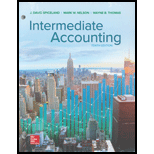
1
Concept Introduction:
Valuation of inventory: It is the cost associated with the cost of inventory at the end of the accounting period. It is based on the cost incurred by the entity to acquire the inventory. There are four generally applied
The ending inventory and cost of goods sold.
2
Concept Introduction:
Valuation of inventory: It is the cost associated with the cost of inventory at the end of the accounting period. It is based on the cost incurred by the entity to acquire the inventory. There are four generally applied inventory valuation techniques: Specific identification method, First in first out method, last in first out method, and weighted average cost method.
The income before income tax for the year assuming operating expenses of $150,000.
3
Concept Introduction:
Valuation of inventory: It is the cost associated with the cost of inventory at the end of the accounting period. It is based on the cost incurred by the entity to acquire the inventory. There are four generally applied inventory valuation techniques: Specific identification method, First in first out method, last in first out method, and weighted average cost method.
The yearend adjustments for LIFO reserves.
4.
Concept Introduction:
Valuation of inventory: It is the cost associated with the cost of inventory at the end of the accounting period. It is based on the cost incurred by the entity to acquire the inventory. There are four generally applied inventory valuation techniques: Specific identification method, First in first out method, last in first out method, and weighted average cost method.
The income before income tax for the year assuming operating expenses of $150,000.
Want to see the full answer?
Check out a sample textbook solution
Chapter 8 Solutions
INTERMEDIATE ACCOUNTING <CUSTOM LL>
 College Accounting, Chapters 1-27AccountingISBN:9781337794756Author:HEINTZ, James A.Publisher:Cengage Learning,
College Accounting, Chapters 1-27AccountingISBN:9781337794756Author:HEINTZ, James A.Publisher:Cengage Learning, Financial AccountingAccountingISBN:9781337272124Author:Carl Warren, James M. Reeve, Jonathan DuchacPublisher:Cengage Learning
Financial AccountingAccountingISBN:9781337272124Author:Carl Warren, James M. Reeve, Jonathan DuchacPublisher:Cengage Learning Intermediate Accounting: Reporting And AnalysisAccountingISBN:9781337788281Author:James M. Wahlen, Jefferson P. Jones, Donald PagachPublisher:Cengage Learning
Intermediate Accounting: Reporting And AnalysisAccountingISBN:9781337788281Author:James M. Wahlen, Jefferson P. Jones, Donald PagachPublisher:Cengage Learning- Principles of Accounting Volume 1AccountingISBN:9781947172685Author:OpenStaxPublisher:OpenStax College



